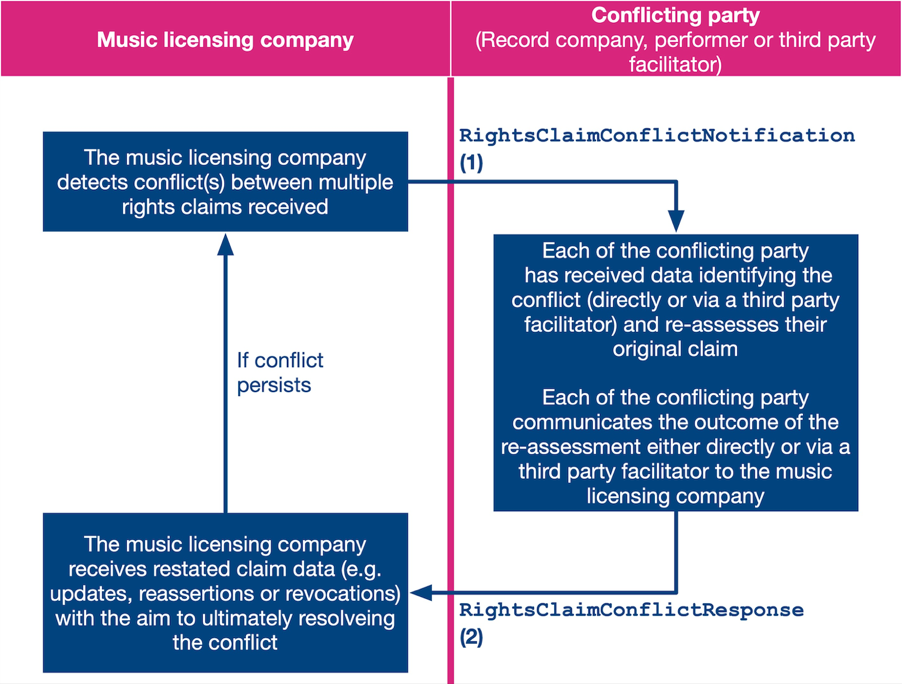RDR-RCC explained
The messages contained in Part 4 (RDR-RCC) of the Recording Data and Rights Standard (RDR) provide a simple mechanism for the communication of data about rights conflicts only for one specific use case: the communication of data from a music licensing company to a claiming party, usually a record company or performer, where the total claims received by the music licensing company in respect of the same rights exceeds 100%.
The RDR-RCC standard is designed to streamline and standardise the resolution of rights claim conflicts between music licensing companies and rights controllers (typically record companies). Its goal is to become the industry’s preferred format for communicating such rights conflicts by offering a clear, scalable solution based on two easy-to-use flat-file messages in .tsv format.
RightsClaimConflictNotification(RCCN): Sent by music licensing companies to inform rights controllers of detected rights claim conflicts.RightsClaimConflictResponse(RCCR): Sent in reply by rights controllers to update, maintain, revoke, or indicate a pending review of their rights claims.
The first of these two message enables a music licensing company to notify claiming parties if one or more of their rights claims are in conflict (i.e. where the total claims exceed 100%). The second message enables conflicting parties to notify the music licensing company that they maintain, update or revoke their earlier made claim(s).
RDR-RCC also outlines the communication process for companies and organisations dealing with neighbouring rights declarations and disputes – typically record companies and performers and music licensing companies – to use this part of the RDR standard alongside existing processes and standard methods of communication, such as Part 2 (RDR-N) of the RDR standard.
Both messages offer a simple solution, using a flat-file in .tsv format, for managing and ultimately resolving rights claim conflicts more efficient and accessible to all players in the neighbouring rights eco system.
Message structure
Both messages follow the DDEX standard format, including a header and footer (not shown in the core data structure). Each message includes defined data categories:
RCCN
The RightsClaimConflictNotification (RCCN) message, communicates data about rights conflicts detected by a music licensing company to the repertoire owner (rights controller).
The message can be split into the following data categories as set out in Figure 1. For the full data requirements per record, please refer to Clause Clause 9.3.4.
RCCR
The RightsClaimConflictResponse (RCCR) message, enables conflicting parties to respond with updated, maintained, or revoked rights claims or inform the music licensing company that their review of the conflict is pending.
Clause 5.1 provides a clear overview of the choreography of the RightsClaimConflictResponse (RCCR) process, while Clause 6.2 outlines the specific types of actions that a conflicting party may wish to express, as detailed below.
The RCCR message sent by the conflicting parties to the music licensing company may include the following types of information:
A rights claim update to revise previously submitted data.
A revocation of a prior claim that was submitted in error.
A reconfirmation of an existing claim to clearly restate and maintain the rights previously declared.
A pending response notification, indicating that the party has received the conflict notification but has not yet been able to fully assess it.
Any update or revocation submitted should trigger the receiving music licensing company to re-evaluate or recalculate the claims currently in conflict.
The message can be split into the following data categories as set out in Figure 1. For the full data requirements per record, please refer to Clause 9.4.
Choreography
Notifications (sent by music licensing companies) and responses (from conflicting parties, usually rights controllers) occur iteratively to resolve rights claims. Please refer to Clause 5.1 for further information.
This ensures compatibility of communication business processes, when using a data hub such as RDX or point-to-to point communication with the XML RDR-N part of the RDR standard.
Flexibility and adoption
RCC is
Designed to work with diverse communication formats (e.g., XML, spreadsheets) for broader accessibility; and
Supports customization through user-defined values and scalable implementations.
Technical details
The RCC standard
Specifies record structures, cell cardinalities and allowed-value sets; and
Includes examples for conflict notification and response messages.


